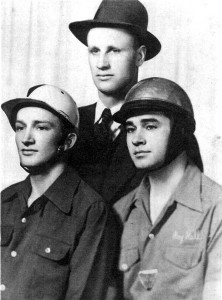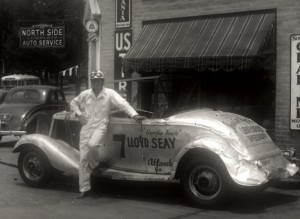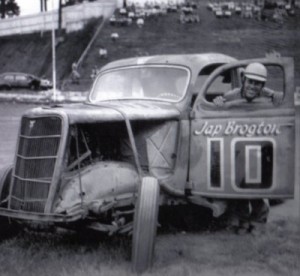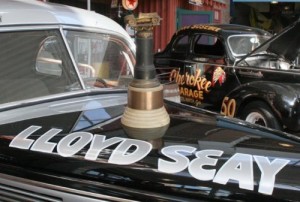The Birth of Thunder Road

The three biggest names in southern stock car racing at it’s infancy-Raymond Parks, Lloyd Seay and Roy Hall.
For years, bootleggers had been bringing load after load of illegal moonshine whiskey out of the hills of Dawsonville, Georgia, and into the thirsty parts of Atlanta. Men like Bob and Fonty Flock and “Rapid” Roy Hall would consistently outrun the law and make their deliveries, their legend and reputation growing with each successful run.
The best driver of these was said to be young Lloyd Seay. Seay was a natural driver, said to be fearless by Georgia lawmen that tried to stop him.
Whiskey trippers, many of Scots-Irish descent, had a knack not only for being good wheelmen, but braggarts to boot. One would claim to have a faster car to another, a bet was made, and the race was on. Eventually, someone got the notion that it would be easier to just get together on a Sunday afternoon in a back field in north Georgia, and let everybody race each other. Local folks would come along to see these races, and at the end of the day, a hat would be passed to reward the winner with a cash prize.

Dahlonega driver Frank Christian saw this, and had a brainstorm. In 1938, he went to Atlanta and put together what would become one of the first organized stock car races in history, to be held at Lakewood Speedway. He invited all the moonrunners to come down and prove who was the best driver.
Seeing this, Seay and his cousin, Roy Hall, convinced their cousin Raymond Parks, who was involved in various legitimate and non-legitimate businesses, to field cars for them in the big race, and advertise his Hemphill Service Station on the sides. Parks had two 1934 Fords prepared by legendary mechanic Red Vogt for the event for Seay and Hall to drive.
Seay charged to the lead and took the win, starting a love affair with racing for all three, and giving race fans in Georgia a hero that was all their own to pull for.
Also bitten by the racing bug was Parks, who would continue to field race cars over the next 15 or so years, becoming one of the most important figures in early stock car racing. Over the next three years, Seay’s reputation, as well as that of Lakewood would continue to grow.

Jap Brogdon won the Lloyd Seay Memorial, run about two months after Seay’s murder. Note that Brogdon’s last name is misspelled on the winning car.
Just as the track played a major role in the start of Seay’s racing career, it would also play a similar role in its end.
Seay’s final career win came at Lakewood on Sept. 1, 1941. Seay started last in the annual Labor Day event, but took the lead by lap 35. He spent the rest of the afternoon battling Bob Flock, and in the end, came away with the win.
The next day, Seay was shot to death by his cousin, Woodrow Anderson, in an argument over the purchase of sugar for the making of moonshine.

The winner’s trophy from the Lloyd Seay memorial is currently on loan to the Georgia Racing Hall of Fame in Seay’s hometown of Dawsonville, Ga.
Later that year, Chamblee racer Jap Brogdon would win the Lloyd Seay Memorial, one of the last major races run before the bombing of Pearl Harbor.
During the war years, the U.S. government banned all forms of auto racing in an effort to conserve materials.
When racing resumed following the war, the AAA Sprint and Indy Cars were among the first to come thundering back to the track. Jimmy Wilburn won in the Mike Benton Sweepstakes in March of 1946.
Ohio driver Ted Horn had a lock on Lakewood’s victory lane for much of the year, winning three AAA events in a row there from June 2 through July 7.
That led up to Labor Day of 1946, and one of the most infamous events in Lakewood’s history.
